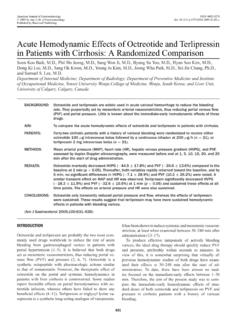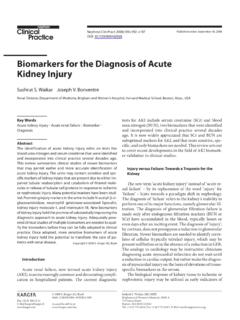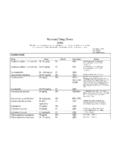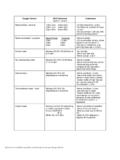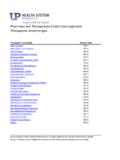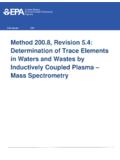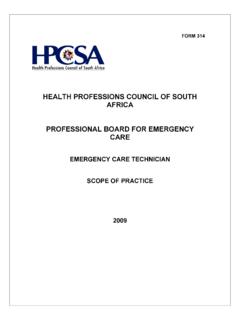Transcription of A Comparison of Albuterol Administered by Metered-Dose ...
1 DOI 2002;121;1036-1041 Chest Kenneth B. Newman, Scott Milne, Cathy Hamilton and Kent Hall *Acute Asthmato an Urban Emergency Department With Albuterol by Nebulizer in Adults PresentingMetered-Dose Inhaler and Spacer With A Comparison of Albuterol Administered by services can be found online on the World Wide Web at: The online version of this article, along with updated information ) ISSN:0012-3692 (of the copyright be reproduced or distributed without the prior written permissionNorthbrook IL 60062. All rights reserved. No part of this article or PDF by the American College of Chest Physicians, 3300 Dundee Road,Physicians. It has been published monthly since 1935. Copyright 2007 CHEST is the official journal of the American College of Chest Copyright 2002 American College of Chest Physicians at Columbia University on August 3, from A ComparisonofAlbuterolAdministered by Metered-Dose Inhalerand Spacer With Albuterol by Nebulizerin Adults Presenting to an UrbanEmergency Department With AcuteAsthma*Kenneth B.
2 Newman, MD, FCCP; Scott Milne, MD; Cathy Hamilton, MPH; andKent Hall, MDStudy objectives:To determine the efficacy of Albuterol by Metered-Dose inhaler (MDI) andspacer compared to a :A prospective, open-label :Large urban emergency department (ED).Patients:All consecutive adult asthma patients over a :ED personnel used a standardized treatment algorithm, which included albuteroladministered by nebulization, for patients presenting to the ED during the first 12 months of thestudy. The treatment algorithm then was switched to one that utilized Albuterol Administered byMDI/spacer as the primary mode of delivery for the following 18 months. As part of theconversion to MDI/spacer, ED staff counseled patients on self-management and supplied patientswith a peak flowmeter, an MDI/spacer, and an inhaled steroid for home :Pulmonary function, clinical outcome, laboratory data, and financial data wereassembled and analyzed from 2,342 ED visits and 1,420 :While there was no significant difference in hospital admission rates between patients inthe MDI/spacer group and the nebulizer group ( and , respectively), there was astatistically greater improvement in peak flow rates in the MDI/spacer group ( vs , respectively; p ).
3 The MDI/spacer group also spent significantly less time in theED ( and 175 min, respectively; p ), had a lower total Albuterol dose (1,125 g and6,700 g, respectively; p< ), and showed a greater improvement in arterial oxygensaturation (p ). Relapse rates at 14 and 21 days were significantly lower (p< andp< , respectively) among patients treated with the MDI/spacer and were associated withasthma education and the provision of a peak flowmeter, a spacer, and an inhaled corticosteroidfor patients home : Albuterol Administered by MDI/spacer is an efficacious and cost-effective alterna-tive to nebulization in adults with acute asthma who present at a large urban ED.(CHEST 2002; 121:1036 1041)Key words:acute asthma; bronchodilators; corticosteroids; education; emergency department; therapeuticsAbbreviations:ED emergency department; HR heart rate; MDI Metered-Dose inhaler; PEFR peak expira-tory flow rate; Sao2 arterial oxygen saturationCurrent guidelines1for the treatment of patientswith acute asthma have recommend the use ofinhaled, short-acting 2-agonists to reverse airflowobstruction.
4 In the emergency department (ED), 2-agonists are Administered by intermittent or con-tinuous nebulization2,3or by Metered-Dose inhaler(MDI), usually with an attached spacer. Historically,nebulization has been the preferred method for*From the University of Cincinnati Medical Center, Cincin-nati, research was supported by the University of Newman is currently an employee of Forest received April 23, 2001; revision accepted October18, to: Kenneth B. Newman, MD, FCCP, 20 Sun-derland Ln, Katonah, NY 10536; e-mail: Investigations Copyright 2002 American College of Chest Physicians at Columbia University on August 3, from administering 2-agonists to young patients or tothose patients who were unable to coordinate theirinhalation with the actuation of an MDI due toagitation or severe , in routineclinical situations, and under the supervision of trainedpersonnel, bronchodilation equivalent to that of nebu-lization can be achieved with high doses of a 2-agonistdelivered by an MDI fitted with a 6 While the effectiveness of nebulization is widelyrecognized, the method nevertheless has severaldisadvantages.
5 Studies indicate that nebulization canbe an inefficient method of delivering aerosol med-ication. Compared to an MDI/spacer combination, anebulizer dispenses more medication but withoutadded therapeutic ,8 The potential for excessdrug exposure is of concern since the inhalation of 2-agonists in high doses can cause nonpulmonaryadverse effects such as tremor and associated with nebulization, which includepurchasing and maintaining equipment and super-vising its use, make this method of administeringbronchodilators more expensive than the requirements, higher drug dosing, andthe costs of maintaining nebulizers and their periph-eral equipment are particularly burdensome for pa-tients in developing regions of the previous studies comparing nebulized bron-chodilators to MDI-dispensed medication have beenconducted using relatively small numbers of patientsin strictly controlled settings.
6 We conducted a large,prospective, open-label study of consecutive adultasthma patients over a period to determinewhether Albuterol Administered by MDI/spacercould replace Albuterol administration by nebuliza-tion in a busy urban ED. We utilized an innovativestudy design in which ED personnel administeredalbuterol by nebulization for 12 months and thenswitched to an MDI/spacer as the primary mode ofdrug delivery for the following 18 months. As part ofthe conversion to the MDI/spacer, the ED staffcounseled patients on self-management and suppliedpatients with a peak flowmeter, a spacer, and aninhaled corticosteroid for home and MethodsPatientsPatients who were admitted to the study were consecutiveadult patients who were 18 years of age and had presented tothe ED of the University of Cincinnati Medical Center fromOctober 1994 to April 1997 with an acute exacerbation of patients with acute asthma who were seen by physicians in theED during this period were included in the study.
7 A total of 2,342ED visits for acute asthma were recorded and statisticallyevaluated. Smoking was not an exclusion criterion in this DesignThe study was designed as an unblinded, nonrandomized trialcomprising two consecutive phases. For the first 3 months of thestudy, ED physicians were allowed to treat patients in theircustomary fashion. After the first 3 months, a uniform depart-mental asthma treatment protocol was implemented, whichincluded nebulized Albuterol as the initial therapy for acuteasthma. This protocol was modeled after National Institutes ofHealth guidelines. At an interim evaluation, it was observed thatthe strategy used by ED physicians to treat patients during thefirst 3 months of the study was essentially the same as thatrecommended by the National Institutes of Health , all patients who were seen during the first year of thestudy were pooled and analyzed as a single population.
8 This phaseof the study (phase 1), during which all patients receivednebulized Albuterol exclusively, comprised 913 individual the following 18 months of the study (phase 2), all EDphysicians were instructed to treat acute asthma patients withalbuterol from an MDI delivered via a spacer (AeroChamber;Monaghan Medical Corp; Plattsburgh, NY). Patients weretreated initially with 5 puffs of Albuterol . They then received anadditional 3 to 5 puffs every 20 min, as needed. To facilitate theimplementation of this protocol and to encourage patient educa-tion, all subjects were given an asthma bag, which contained thefollowing materials: an MDI/spacer, an MDI- Albuterol canister, apeak flowmeter, an instructional pamphlet that included a per-sonal asthma diary, and a canister of an inhaled corticosteroid(Aerobid; Forest Laboratories; New York, NY).
9 At their discre-tion, physicians were permitted to break protocol if in theirjudgment the patient s physical or mental status would benefitfrom a different mode of therapy. A total of of phase 2patients received nebulized Albuterol rather than Albuterol byMDI/spacer. The change was usually based on the clinicaljudgment of a physician or was due to the unavailability ofMDI/spacer supplies (approximately 2% of patients). A signifi-cant proportion of phase 2 patients ( ) who receivednebulized Albuterol were switched to Albuterol Administered byMDI after receiving an initial dose by AnalysisDuring phase 2 of the study, patients were analyzed on anintention-to-treat basis, not by the therapy they had received. Inexcess of 100 individual data fields were identified prospectively,with data elements for each patient recorded on a physicianquestionnaire, which then were entered into a microcomputer-ized database program.
10 This method allowed the data to be easilycollected, manipulated, and imported into the statistical evalua-tion program (SPSS, version ; SPSS Inc; Chicago, IL). Thequestionnaire used as an instrument for the collection of standardpatient information that included the hospital patient numberand pertinent biographic data such as gender, age, race, phone,primary physician, or clinic location. Medically significant issuespertaining to each ED visit also were abstracted. Such issuesincluded the following: presumptive presenting diagnosis; cur-rent medications; and the method and dosage of first andsubsequent medications given in the ED. Issues pertaining topatient administration and finance also were collected. Theseincluded the total amount of time spent in the ED, the length oftime before the patient was seen by a physician, and the chargesfor the visit.




